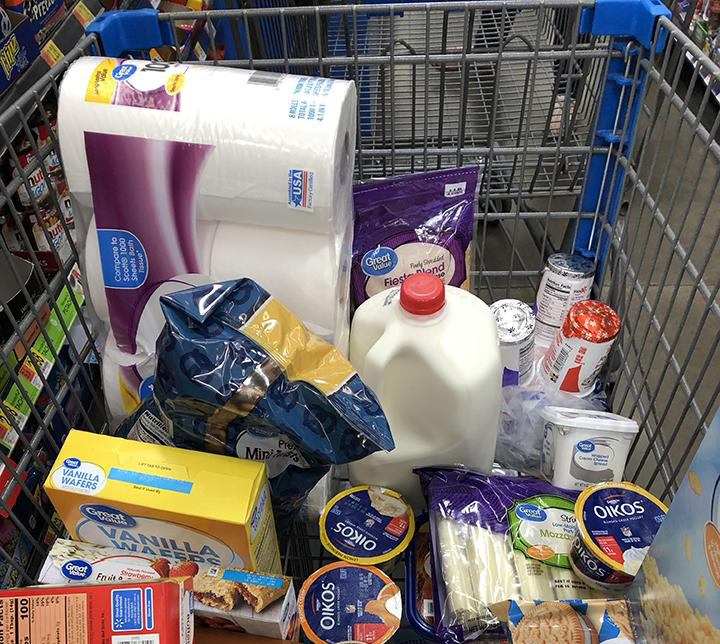| Issue #53 • September/October, 1998 |
There was a time when I despised grocery shopping. Every time I walked into a grocery store it seemed the dollars were simply sucked out of my wallet. If it felt like I was getting ripped off, I probably was. Fed up with spending over a hundred dollars and walking out with only a week’s worth of food, I found a number of easy ways to cut my family’s food bill in half.
Shop around
Loyalty to your favorite spacious and contemporary supermarket is a guaranteed way to throw money down the drain. I have yet to find a store that carries the cheapest of every possible item. Open your mind to a variety of different possibilities. Look for bulk food stores, canned goods outlets, restaurant supply stores, or food coops. They all may offer some great prices. The local butcher may also have some highly competitive prices on meat. Butchers are a great way to get in touch with farmers who are willing to sell a cow or hog for a good price. Roadside stands often have the best deals on quality produce. They are also more open to negotiation and even bartering.
Cut out the middleman
Every time you buy a product in the grocery store you pay the farmer, processor, packager, distributor, and the grocery store, who in turn pay the stocker and checker, not to mention the mortgages on all those buildings. Try buying direct from the farmer.
There is bound to be some locally grown produce in your area. Check fruit orchards for seasonal deals, or herb farms (dehydrate your own spices). Stopping buy the local farmer’s market on the weekend while running errands can be a great way to buy direct and meet local farmers. If you are anywhere near the ocean try taking a trip to the harbor docks and buy direct from fishing boats or crabbing vessels.
Plan your route
I know most hard working people are already short of time, and probably the thought of shopping at four or five different stores makes you shake your head. But I used to stop at the supermarket a couple of times a week anyway, and that was outside of the “big” bi-weekly trip.
Some store’s have monthly sales. Plan on stopping at these once a month towards the beginning of the sale. Twice a month plan your bulk grocery shopping. Bring out the advertisements and plan your route. It may seem overwhelming at first but I spend far less time (and money) now that I’ve stocked my pantry full of loss leader sale items.
Get gutsy and try generic
If you have shunned away from generic or store brands because of childhood memories of flat white and black boxes, it’s time to try them again. They taste fine and the price is even better. In today’s competitive market the stores have taken it upon themselves to produce higher quality foods than ever. I have even heard that they are often packaged in the same processing plants. As for frozen vegetables, frozen broccoli spears is frozen broccoli spears, no matter what brand the package reads.
Avoid convenience foods
When was the last time that a frozen pizza filled your family up. Try new recipes for pizza dough, and pile on the toppings. With far less money you can truly have pizzeria quality at home.
If you still waste money on serving-size juice boxes for the kids, invest in some reusable plastic juice glasses, fill them with bulk-bought juice, and keep them in the refrigerator for the kids to grab. It pays.
Be an educated consumer
Knowing your prices will help you save money in many ways. Do you ever get mad at your spouse because he’ll spend twice the going price for ice cream? Over time you have probably become educated and memorized prices for frequently bought items. I once had a friend that gasped in horror when the price of macaroni and cheese was raised a nickel a box. Sure her hubby still laughs about it, but she was truly shocked over the price increase.
Make up a list with the best unit prices you’ve ever found on regularly bought items. Try beating these prices every time you go to the store. You’ll soon learn the difference between true sales and “sale priced” items.
Figure unit prices
Bigger is not always better. Take a calculator along to figure out unit prices quickly. Some supermarkets have it conveniently posted on shelf tags already. Use what is available.
Taking the time to figure unit prices will save money. Are you buying the “family value” packaged goods because they indicate value? It may shock you to find that in comparison to the average size there may be little savings, and sometimes they cost more. Don’t believe packaging; the truth is revealed in the numbers. Figure out the price per unit of measurementper pound, per ounce, per gallon. The other day I compared the prices of a 5-pound bag of russet potatoes for 69-cents and a 10-pound “sale” bag for $1.79. Buying two 5-pound bags would save 41-cents over one 10-pound bag.
Buy big
When you find an excellent deal it’s time to stock up your pantry. If you find an unbelievably low price, spend an extra $5 or $10 and buy enough to last until the next sale.
My husband laughed at me when I came home with 33 bottles of name brand BBQ sauce. It may have been crazy if the price had not been 29 cents a bottle, I have yet to see it cheaper, and because we love BBQ sauce not one bottle went to waste.
I’ve also been mocked by a teenage checkout boy because I was “buying out the meat department.” Maybe if he had to pay his own rent he would have taken note. The cut up fryers were on sale for a third the normal price. I had bought $90 worth of good meat for only $30 cost. I didn’t have to buy another chicken for months. I could have bought one or two extra, then paid full price a week later. Fill your freezer and your pantry with the highest quality foods available at the lowest possible price.
Get a rain check
Are they out of the cans of soup that were a loss leader sale. Ask a stock person to check the back; many times the shelves are cleared so fast that stock people can barely keep up.
If there are no more to be found, get a rain check and have one made up in your child’s name also.
Most stores are happy to fill out a rain check. It’s a little slip of paper that allows you the sale price when the new stock arrives, even if the sale is over.
Bypass customer limits
If your store lures you in with loss leaders and then slaps a limit on the number you can purchase, it’s time for a creative solution. Every one of your children are a potential customer (the store never complains when they buy a candy bar). Split up the family and build more purchasing power.
Every time you walk into a store you are a potential customer. I will make repeated trips to the store for a great loss leader sale. You should too. The grocery store is trying to lure you into spending more so it’s time to beat them at their own game.
Get the inside scoop
Ask your friendly grocer when they roll out the day old bread rack. This is a great way to fill up the freezer for half price. Do they fill up the discounted or damaged foods cart on a specific day each week? If they bring out the sale items Friday morning, plan accordingly.
Make them work for you
If you are filling lunch boxes with expensive bologna and packaged ham, here is an easy solution that can save you a lot of money. Does your grocery store have a butcher or a deli? Instead of paying $3.99 a pound for sliced sandwich ham, pick a whole or half ham from the meat cooler, and have them slice it. Many markets are happy to slice it as thin as you’d like, for free. This can result in big savings because whole hams are sold for far less ($1.75 per pound).
Your butcher may also be willing to slice big chunks of cheese for you.
Double up savings
I rarely use coupons because they are often for overpriced foods. However, double coupon day can sure bring down the prices. My daughter and I now look through the local coupon exchange bin at the library for possible great deals. The combination of free coupons and double coupon day gets us cans of chili for a quarter, and other items for next to nothing.
Double up the deals by combining coupons, sale items, and rebates. It does take some time, but for some people the deals add up. Call the 1-800 phone numbers on the packaging of your favorite products; many will send coupons directly to you if you ask.














